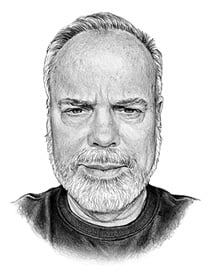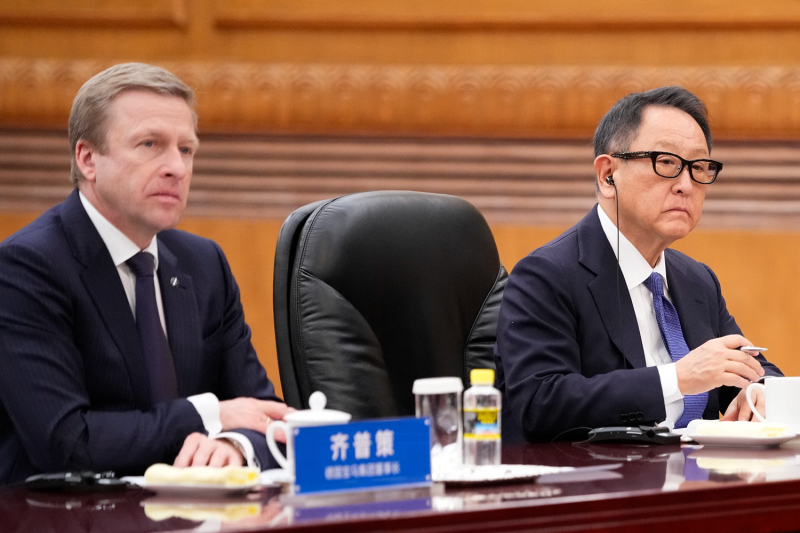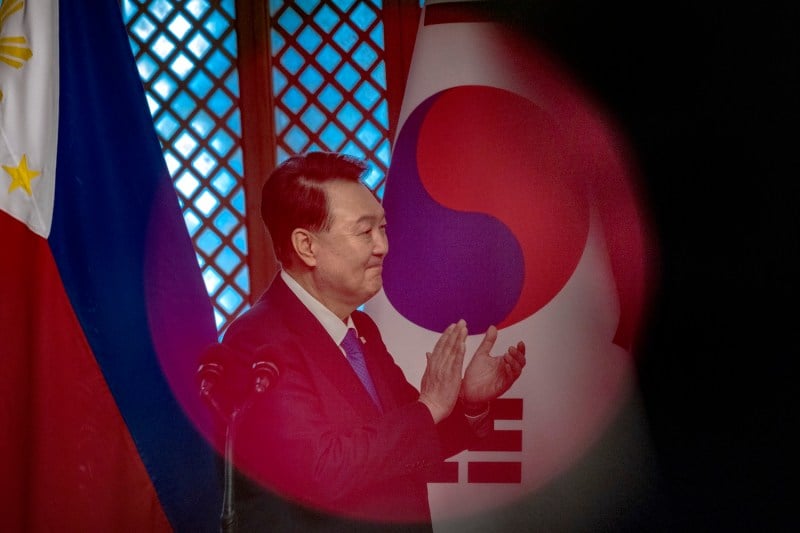Tariffs Can Actually Work—if Only Trump Understood How

Argument
Tariffs Can Actually Work—if Only Trump Understood How
Smart trade policy could help restore jobs, but the president’s carpet-bomb approach portends disaster.
Workers churn out American flags on a factory floor in Valley Forge, Pennsylvania, circa 1982. Beatriz Schiller/Getty Images
As U.S. President Donald Trump launched his new global trade war on Wednesday—what he dubbed a “declaration of economic independence”—he delivered what may be the most delusional account of modern economic history ever to be heard from the White House.
Trump said the United States has been “looted, pillaged, raped, and plundered” by “friend and foe alike” for “more than 50 years.” He declared, absurdly, that “none of our companies are allowed to go into other countries” even though U.S. goods and services exports exceeded $3 trillion in 2024 after steadily rising over the past two decades. Trump suggested, even more absurdly, that the Great Depression would never have happened had Washington not lifted its tariff policies more than 100 years ago.
As U.S. President Donald Trump launched his new global trade war on Wednesday—what he dubbed a “declaration of economic independence”—he delivered what may be the most delusional account of modern economic history ever to be heard from the White House.
Trump said the United States has been “looted, pillaged, raped, and plundered” by “friend and foe alike” for “more than 50 years.” He declared, absurdly, that “none of our companies are allowed to go into other countries” even though U.S. goods and services exports exceeded $3 trillion in 2024 after steadily rising over the past two decades. Trump suggested, even more absurdly, that the Great Depression would never have happened had Washington not lifted its tariff policies more than 100 years ago.
And on Wednesday by reimposing stiff tariffs on just about every country, Trump declared that “jobs and factories will come roaring back” to foster a new “golden age,” and that “April 2, 2025, will forever be remembered as the day American industry was reborn.”
That’s highly unlikely to happen. On the contrary, the neutron bomb that Trump dropped on the global economic system on April 2 could portend a death spiral—especially for leading U.S. manufacturers that depend on global supply chains. On Wall Street, the markets plunged on Thursday, led by a huge sell-off of technology stocks.
Moreover, the U.S. corporate sector—along with the rest of the world—reacted with horror at the crude arithmetic behind the new Trump policies, along with the investment-dampening uncertainties created by them. The array of tariffs that Trump announced appeared to be based on a simplistic formula by which U.S. trade deficits in goods (not services) were divided by imports—reflecting Trump’s ill-conceived idea that countries are like corporations and trade surpluses are in effect profits, while deficits are losses.
Take China. If one divides the U.S. deficit of $295.4 billion with China in 2024 by the amount of imported goods from China, $438.9 billion, the result is 67 percent, which is what Trump said on Wednesday is effectively China’s tariff on U.S. goods. The Trump team then divided that number approximately in half to determine that the United States’ “reciprocal” tariff on China would be 34 percent.
There is no apparent economic rationale to support this.
“This is not policy—it’s really stupidity,” said Nobel Prize-winning economist Joseph Stiglitz, who has also long supported progressive trade that deploys tariffs.
Trump’s approach suggests that his pre-Adam Smith, mercantilist view of trade deficits, which he held in his first term, hasn’t changed at all. It also suggests that he’s largely unfamiliar with the last 250 years of economic theory, which have shown undeniably that trade is not the zero-sum game that Trump thinks it is but rather benefits all.
Trump appears to pine for an irretrievable past that was dominated, briefly, by his 1890s-era hero, President William McKinley, who—like Trump—described himself for a time as “tariff man.” That was an era when today’s strongest U.S. manufacturing sector, technology, didn’t exist, and no one even knew what “services” were.
“This is mind-boggling to economists,” said Stiglitz. “It’s absolutely absurd, particularly because it precludes services in a 21st-century economy in which services such as telecom, education, and finance represent 20 percent [of the country’s GDP], and manufacturing is only 10 percent.”
Adam Hersh of the progressive Economic Policy Institute, which has also long supported tariffs as a trade tool, was no less harsh.
“This is going to go down in history as the worst economic policy mistake that’s ever been made by a head of state,” he said. “It is so thoughtless and reckless it just boggles the mind.”
Donald Trump gestures while speaking at Drake Enterprises, an automotive parts manufacturer and supplier, in Clinton, Michigan, on Sept. 27, 2023, during his campaign to run for a second presidential term.Matthew Hatcher/AFP via Getty Images
The sad irony in all this is what Trump is missing. Smart and strategic trade policy—one that includes surgically targeted tariffs and other threats of trade sanctions—can actually achieve what the president has said is one of his main goals: pressuring other countries to invest in the United States and create American jobs.
U.S. policymakers proved that decades ago, when they took on the closed economy known as Japan Inc. Throughout the 1980s and 1990s, both Republican and Democratic administrations imposed waves of sanctions and forced Tokyo to raise the value of the yen. In Japan, this was known as gaiatsu—and it helped restructure the economy. Japan’s giant corporations decided, over many years, to partially abandon what had become a slow-growth economy and started moving massive amounts of manufacturing to the United States.
As a result—to a startling degree, to many Americans—the Japanese companies became “us” rather than “them.” Thirty years ago, political hostility to Japanese manufacturing was so intense that people used to spit on or scratch parked Toyotas and Nissans. Today, “Japanese” cars are ubiquitous on U.S. roads, and almost no one cares because most are built or assembled in the United States. In 2024, Japanese automakers produced more than 3 million vehicles at production facilities in the United States—twice as many as were imported from Japan.
While the United States still has a substantial ($68 billion) trade deficit with Japan, it has declined over time. And when Prime Minister Shigeru Ishiba visited Washington in February, he noted that Japanese companies have held the top spot for cumulative foreign direct investment in the United States over the past five years. Knowing how this would impress Trump, Ishiba added that Japan was looking to invest more in the United States.
Last week, after Trump announced 25 percent levies on imported cars and parts, Ishiba lamented that Trump’s views on tariffs were “difficult to understand.”
“There’s no question that the pressure we put on Japan back in the 1980s and ‘90s encouraged a lot of Japanese companies to invest more in the United States,” said Matthew Goodman of the Council on Foreign Relations, who served as an international economist at the U.S. Treasury Department in that era, including five years as a financial attaché at the U.S. embassy in Tokyo. “They wanted to be behind any protectionist wall we would create,” he added.
Oddly, Trump seems unaware of this profound progress, slamming Japan in his remarks Wednesday and complaining that “94 percent of the cars in Japan are still made in Japan.” For good measure, he slapped Tokyo with another 24 percent tariff.
#gallery-2 {
margin: auto;
}
#gallery-2 .gallery-item {
float: left;
margin-top: 10px;
text-align: center;
width: 100%;
}
#gallery-2 img {
border: 2px solid #cfcfcf;
}
#gallery-2 .gallery-caption {
margin-left: 0;
}
/* see gallery_shortcode() in wp-includes/media.php */
- Cars are assembled on the production line at a Toyota factory in Japan on April 10, 1980. The Asahi Shimbun via Getty Images
- Doors for Honda Civics make their way down the assembly line at the Japanese automaker’s plant in Greensburg, a town in the U.S. state of Indiana, seen on March 17, 2011. Mira Oberman/AFP via Getty Images
Nonetheless, Trump is stumbling in the dark toward a similar goal, and he may have some limited success in building his own “protectionist wall.”
On the threat of greater tariffs—and because of the U.S. defense umbrella—South Korea’s Hyundai has just announced a $21 billion investment that will include a new steel plant with more than 1,400 employees in red-state Louisiana. Taiwan Semiconductor Manufacturing Co. (TSMC) and Japan’s SoftBank have also announced major U.S. onshoring plans in recent months in an effort to avoid Trump’s wrath and tariffs.
And some major U.S. companies are responding by gesturing, at least, at onshoring: Apple said in February that it is investing billions in microchip production facilities in Texas. Intel and Micron have also said they’re going to build at home.
It’s not that Trump isn’t registering a legitimate complaint. In his speech, he noted that he’s been complaining about chronic trade deficits for 40 years, since he was a brash builder in Manhattan, as well as the unfair extent to which the United States supports a stable global economy.
“We take care of countries all over the world,” he said. “We pay for their military. We pay for everything they have to pay. And then when you want to cut back a little bit, they get upset that you’re not taking care of them any longer. But we have to take care of our people, and we’re going to take care of our people first, and I’m sorry to say that.”
That message has strongly resonated with U.S. voters disturbed by the cavalier approach that both the Republican and Democratic parties have taken toward open trade. They fecklessly promoted globalization and did little to compensate the middle class for the brutal displacement of old industries and jobs. For two generations, policymakers who questioned free trade and pushed for “fair trade”—more tariffs, unemployment insurance, and worker protections—were edged out of the discussion.
Washington also completely deregulated Wall Street, allowing investment flows to facilitate the offshoring of production to low-wage countries, especially China.
Trump Treasury Secretary Scott Bessent has even revived the idea of the 1985 Plaza Accord—an agreement between the then-Group of Five countries of France, Germany, the United States, the United Kingdom, and Japan for market intervention to depreciate the dollar, mainly against the Japanese yen.
Bessent and Stephen Miran, who chairs the White House Council of Economic Advisers, have floated the idea of a “Mar-a-Lago accord” that would combine tariffs with a devaluation of the dollar, thus making U.S. products more competitive.
A circa-1896 political cartoon depicts President William McKinley as a physician dispensing tariff medicine to various characters at a sanatorium. A sign on one man’s bed in the foreground reads “Hallucinations About Home Markets and Infant Industries.” Photo12/Universal Images Group via Getty Images
Trump doesn’t seem to appreciate that this is not the 1980s. No nation is likely to go along with a Plaza Accord-style deal today—especially with Trump eager to withdraw the U.S. defense umbrella from Europe and other places. Beyond that, a strong dollar is a mainstay of U.S. global power. The fact that the dollar is the world’s reserve currency means that, unlike other currencies, it cannot devalue to correct trade imbalances. Hence, importers retain an advantage over U.S. domestic producers—which is one reason that the U.S. suffers chronic deficits.
It’s also not the 1890s, when McKinley declared, “I am a tariff man, standing on a tariff platform.” In his remarks on April 2, Trump harked back to that supposed shining moment. “From 1789 to 1913, we were a tariff-backed nation, and the United States was proportionately the wealthiest it has ever been,” he said.
But back then, the United States was still a developing nation that specialized in heavy industry and agriculture—and did not uphold the global order. Even McKinley himself eventually came out against tariffs. Nor is today’s business environment even remotely like it was just 20 years ago, before global supply chains for U.S. corporations became so complex and spread out across continents.
“The world has moved on,” Stiglitz said. “Even if we got back 10 percent more manufacturing jobs, which would be enormous, that’s only 1 percent of the labor force. That’s not going to transform our economy.”
Stiglitz added: “I was just in China recently. The fact is that they have 10 times or so the engineers we do. And they are committed to science, while the Trump administration is scaling back on investment in science. We cannot, without engineers, be the leaders in modern manufacturing. In addition, most modern manufacturing doesn’t even use much labor anymore. It uses robots.”
A worker places components on a production line at a semiconductor production facility in Gao’an, located in China’s Jiangxi province, on Jan. 10, 2024. Costfoto/NurPhoto via Getty Images
U.S. companies that rely on sophisticated supply chains are now going to be hit in multiple ways. In recent years, Apple and other high-tech companies have sought to diversify these chains, moving to Vietnam and other Southeast Asian nations to avoid the China tariffs that became common for President Joe Biden as well as Trump. But Trump now has slapped most of those countries with heavy levies. Goods from Vietnam, for example, face a 46 percent tariff.
Trump also jettisoned Biden’s industrial policy plans, which most progressive economists see as essential tools along with tariffs.
“It’s giving a bad name to tariffs, and tariffs have been and can be effective tools in promoting industrial development,” said Hersh, from the Economic Policy Institute. “But tariffs are not sufficient on their own. They have to be combined with all kinds of other policies, subsidies, and credits,” he added, including expenditures such as those that came out of Biden’s Inflation Reduction Act as well as his CHIPS and Science Act.
All those uncertainties will more than counteract the incentives that Trump is creating, said Nathan Lane, an American economist at Oxford University, who calls the Trump tariff policy “more incoherent than we expected.”
“If you reshore something, those large capital projects take a long time, and so if policy is going to change by then, they’ve taken away the certainty that entails building here in the U.S.,” Lane said. “You really want to set expectations for the private sector properly. That clarity is part of doing industrial policy right.”
Not surprisingly, Apple led the Wall Street rout among the so-called Magnificent Seven group on Thursday. This reflects a long-term chilling effect on companies that rely not just on low-wage labor from abroad, but also on technical and scientific skills that many U.S. workers don’t have—and which, thanks to Elon Musk’s dramatic cost-cutting campaign affecting education and science, Americans are even less likely to get now.
As Forbes magazine commented, “For the first time in decades, tech giants must navigate a world where production costs are rising instead of falling.”
“I’m not sure it’s possible to revive U.S. manufacturing when your supply chain is subject to a global trade war,” Lane said. “You may incentivize bringing one slice of the value chain back. Yet you’re hitting the rest of the chain with volleys of tariffs.”
The bottom line is that, whereas the gaiatsu of that earlier era was surgical, Trump’s scattershot approach could very well tank the world economy while unraveling it for good. Pressure against Japan worked 30 years ago in part because it was singled out, and U.S. security guarantees during the Cold War meant that Japan was not going to retaliate.
But now, Trump is threatening to withdraw security protection from U.S. allies extending from Europe to South Korea, while at the same time threatening them over trade. They’re almost all going to retaliate, and tariffs could reach the same levels that helped exacerbate the Great Depression.
It’s not surprising that, rather than kowtowing to Trump, some governments and companies are ready to look for alternatives. Japan’s Suntory Holdings said on Thursday that it might bypass the U.S. market altogether and shift its whiskeys to its home market and other Asian nations.
French President Emmanuel Macron, calling the tariffs “brutal and unfounded” in remarks on Thursday, proposed a pause on investment in the United States.
“What would the message be, of having big European players that invest billions in the American economy at the same time they are hitting us?” Macron said. “We must have collective solidarity.”
This post is part of FP’s ongoing coverage of the Trump administration. Follow along here.
Michael Hirsh is a columnist for Foreign Policy. He is the author of two books: Capital Offense: How Washington’s Wise Men Turned America’s Future Over to Wall Street and At War With Ourselves: Why America Is Squandering Its Chance to Build a Better World. X: @michaelphirsh
More from Foreign Policy
-

An illustration shows a golden Cybertruck blasting through a U.S. seal of an eagle holding arrows and laurel. Is America a Kleptocracy?
Here’s how life could change for the rich, poor, and everyone in between.
-

The flag of the United States in New York City on Sept. 18, 2019. America Is Listing in a Gathering Storm
Alarms are clanging at the U.S. geographic military commands around the globe.
-

U.S. President Donald Trump shakes hands with Supreme Court Chief Justice John Roberts during Trump’s inauguration in Washington, D.C. The U.S. Judicial Crisis Is Uniquely Dangerous
But other democracies provide a roadmap for courts to prevail over attacks from the executive branch.
-

An illustration shows a golden Newtons cradle with Elon Musk depicted on the one at left and sending a globe-motif ball swinging at right. Elon Musk’s First Principles
The world’s richest man wants to apply the rules of physics to politics. What could go wrong?
















Join the Conversation
Commenting on this and other recent articles is just one benefit of a Foreign Policy subscription.
Already a subscriber?
.
Subscribe
Subscribe
View Comments
Join the Conversation
Join the conversation on this and other recent Foreign Policy articles when you subscribe now.
Subscribe
Subscribe
Not your account?
View Comments
Join the Conversation
Please follow our comment guidelines, stay on topic, and be civil, courteous, and respectful of others’ beliefs.
Change your username |
Log out
Change your username:
CANCEL
Confirm your username to get started.
The default username below has been generated using the first name and last initial on your FP subscriber account. Usernames may be updated at any time and must not contain inappropriate or offensive language.